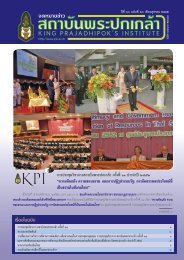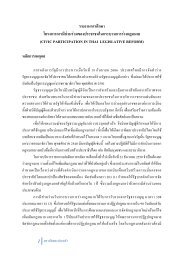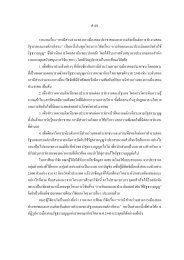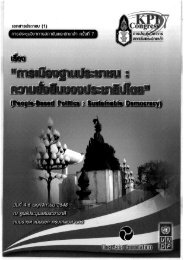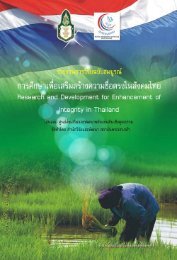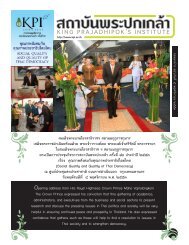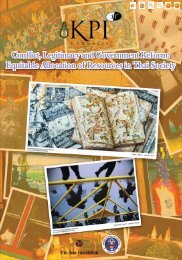SUFFiciENcy EcONOMy ANd GRASSROOtS DEvElOPMENt
SUFFiciENcy EcONOMy ANd GRASSROOtS DEvElOPMENt
SUFFiciENcy EcONOMy ANd GRASSROOtS DEvElOPMENt
You also want an ePaper? Increase the reach of your titles
YUMPU automatically turns print PDFs into web optimized ePapers that Google loves.
234<br />
The Meaning of Sufficiency Economy <br />
International Conference<br />
‘SUFFICIENCY ECONOMY’ IN THAILAND<br />
The Asian currency crisis in 1997 led H. M. the King of Thailand to denounce<br />
the export-oriented economy as the sole option for the peasants, and the King<br />
launched a concept on “sufficiency economy”, which encourages the peasants to<br />
produce food and other commodities first and foremost for themselves, secondly to<br />
the domestic market, and only thirdly to the export market. <br />
The concept “sufficiency economy” is, however, rather vague and unclear in<br />
the theoretical literature in economics. The UNDP Report (2007) gives a following<br />
definition: <br />
“Sufficiency in this sense should not be confused with self-sufficiency,<br />
turning inward, rejecting globalization, or retreating towards the mirage of a<br />
simpler world. Rather, this approach offers a way to cope with the<br />
unavoidable realities of the market and globalization in the contemporary<br />
world. The Sufficiency approach stresses that individuals need a certain<br />
measure of self-reliance to deal best with the market, and countries need a<br />
certain measure of self-reliance to deal with globalization. Sufficiency has the<br />
dual meaning of ‘not too little’ and ‘not too much.’” 1 <br />
Despite the warnings, “sufficiency” often translates into “self-sufficiency” <br />
as seen in many references. 2 Such concepts as economic “sufficiency”, “selfsufficiency”<br />
and “self-reliance” are confusing and not well founded or well<br />
explained in the theoretical literature. There are very few examples of policies that<br />
would have been carried out in the name of “Sufficiency Economy”. For the last<br />
couple of centuries, ever since the popularization of the economic ideas of Adam<br />
Smith (1723-90) 3 , the world leaders have been divided into two camps, those who<br />
promote opening of the markets, borderless trade opportunities, low tariffs or no<br />
tariffs and to those who for various reasons have preferred to close their markets,<br />
limit the imports, set up high tariffs and resort to import substituting industries<br />
(ISI). Somewhere in this spectre also the “sufficiency economy” finds it ideological<br />
home.<br />
Another term often linked to “sufficiency”, “self-sufficiency” or “selfreliance”<br />
is “autarky”, which according to a dictionary definition is: “a selfsufficient<br />
economy with no external trade. The term is often used in economics to<br />
describe policies of decreasing reliance on external trade by tariffs and quotas”. 4<br />
The King’s speech inspired the official Thai establishment to promote<br />
sufficiency economy. The controversial Buddhist Asoke group, vilified by some<br />
1<br />
UNDP report “Sufficiency Economy and Human Development” 2007. <br />
2<br />
Shawn W. Crispin in Asia Times online October 5, 2006.<br />
3<br />
See his “An Inquiry into the Nature and Causes of the Wealth of Nations” from 1776, but<br />
reprinted several times and much quoted and misquoted by economists.<br />
4<br />
The New Penguin Encyclopedia 2003.



